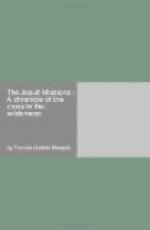Huronia lay in what is now the county of Simcoe, Ontario, comprising the present townships of Tiny, Tay, Flos, Medonte, and Oro. On the east and north lay Lakes Simcoe and Couchiching, the Severn river, and Matchedash Bay; on the west, Nottawasaga Bay. Across the bay, or by land a journey of about two days, where now are Bruce and Grey counties, lived the Petuns, and about five days to the south-west, the Neutrals. The latter tribe occupied both the Niagara and Detroit peninsulas, overflowed into the states of Michigan and New York, and spread north as far as Goderich and Oakville in Ontario. All these nations, and the Andastes of the lower Susquehanna, were of the same linguistic stock as the Iroquois who dwelt south of Lake Ontario. Peoples speaking the Huron-Iroquois tongue thus occupied the central part of the eastern half of North America, while all around them, north, south, east, and west, roamed the tribes speaking dialects of the Algonquin.
Most of the Huron [Footnote: The name Huron is of uncertain origin. The word Huron was used in France as early as 1358 to describe the uncouth peasants who revolted against the nobility. But according to Father Charles Lalemant, a French sailor, on first beholding some Hurons at Tadoussac in 1600, was astonished at their fantastic way of dressing their hair—in stiff ridges with shaved furrows between—and exclaimed ’Quelles hures!’—what boar-heads! In their own language they were known as Ouendats (dwellers on a peninsula), a name still extant in the corrupted form Wyandots.] towns were encircled by log palisades. The houses were of various sizes and some of them were more than two hundred feet long. They were built in the crudest fashion. Two rows of sturdy saplings were stuck in the ground about twenty-five feet apart, then bent to meet so as to form an arch, and covered with bark. An open strip was left in the roof for the escape of smoke and for light. Each house sheltered from six to a dozen families, according to the number of fires. Two families shared each fire, and around the fire in winter clustered children, dogs, youths, gaily decorated maidens, jabbering squaws, and toothless, smoke-blinded old men. Privacy there was none. Along the sides of the cabin, about four feet from the ground, extended raised platforms, on or under which, according to the season or the inclination of the individual, the inmates slept.
The Huron nation was divided into four clans—the Bear, the Rock, the Cord, the Deer—with several small dependent groups. There was government of a sort, republican in form. They had their deliberative assemblies, both village and tribal. The village councils met almost daily, but the tribal assembly—a sort of states-general—was summoned only when some weighty measure demanded consideration. Decisions arrived at in the assemblies were proclaimed by the chiefs.




